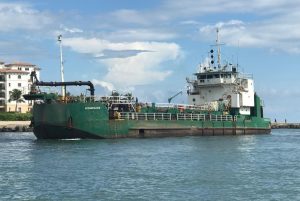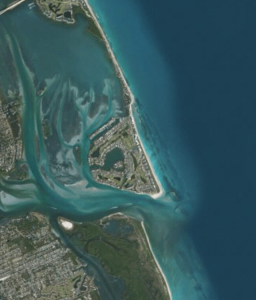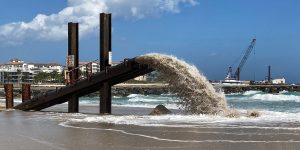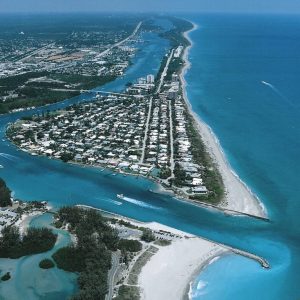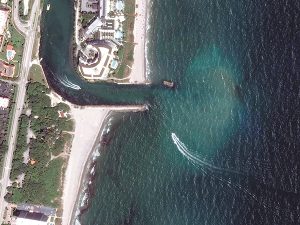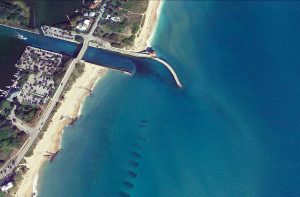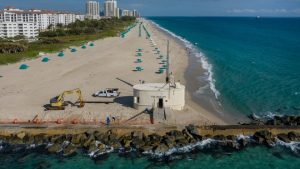Lake Worth Inlet: Engineering Against Mother Nature
The Lake Worth Inlet in Palm Beach County, Florida doesn’t seem like an engineering masterpiece on the the surface of things. After all, what is so special about digging a trench through some sand so boats or ships can pass through? On the grand scheme of things yes, digging a trench is the easy part but Mother Nature always has other surprises for man when we disrupt the natural order of things and requires a bit more engineering and thought to overcome. For this article to make more sense, it may be best to check out my previous article History: Lake Worth Lagoon https://www.sandhillcharters.com/post/history-lake-worth-lagoon
The Palm Beach Inlet, also known as the Lake Worth Inlet, is a man made, 35 foot deep, 400 foot wide and 0.7 mile long dredged out cut, featuring extended jetties on the north and south sides. This inlet connects the Atlantic Ocean to the Lake Worth Lagoon which makes up part of the Intracoastal Water Way along Florida’s east coast. The Inlet has undergone many transformations, locations and improvements since Augustus Oswald Lang, considered the first white settler to the area, hand dug a small cut to the once fresh water and originally named, Lake Worth Lake. Since the 1860’s the Lake Worth Inlet has either shifted locations under the force of Mother Nature or was purposefully relocated by man made attempts to combat every inlets biggest obstacle. It wouldn’t be for about another 100 years when a solution to an ongoing problem was implemented and put into use despite the solution having already been implemented 20 years prior. It would take until the summer of 1958 for the Inlet to be mostly finalized once and for all.

The challenge any inlet faces is silting up and closing off from a natural occurrence called Littoral Drift. In order to better understand why Littoral Drift is such an issue, lets first look at what it is. “Researchers have learned that sand is in constant motion along the coastline, and only resides temporarily on an individual beach. An alongshore or littoral current is developed parallel to the coast as the result of waves breaking at an angle to the shoreline. This current and the turbulence of the breaking waves, which serve to suspend the sand (in the water column) are the essential factors in moving sand along the shoreline. As waves approach the beach at an angle, the up-rush of water, or swash, moves the sand at an angle onto the shoreface. The backwash of water rushes down the shoreface perpendicular to the shoreline or at a slight downcoast angle. Littoral drift can be thought as a river of sand moving parallel to the shore, moving sand from one coastal location to the next” (https://sandshed.org/sandshed-science/what-is-littoral-drift/). Despite the Gulf Stream moving north along the east coast of Florida, the littoral drift tends to be downcoast (moving south), though depending on conditions can move in either direction.

If we take a look at the image (Littoral drift effects, Lake Worth Inlet), the right side being North and the left side being South, we can see how the sand flowing in the southward direction, (indicated by the yellow lines and arrows) begins to pile up on the northern side of the Lake Worth Inlet jetty. You can also clearly see how far setback in the westerly direction the southern shoreline is in relation to the northern shoreline. As you move into the inlet you see Peanut Island and to both the north and south, you can see the sand piling up as the tide flows in and out as seen by the lighter shading of water. The deep blue area of the inlet heads due west toward the Port of Palm Beach is is dredged to a depth of 35ft with the ICW channel passing to the west of the island. This shoaling or silting effect not only hinders deep draft vessels using the inlet but as we see in the Saint Lucie (Stuart), Jupiter, Boca, Boynton and especially Haulover inlets, it can create quite the navigational dangers. Coupled with shallower and narrower inlets, shoaling can virtually guarantee the potential of running aground all thanks to littoral drift. In the slideshow images, you can see where the sand piles up among the inlets from both tidal shifts and littoral drift. But there is a bigger issue to contend with.
The biggest challenge surrounding littoral drift and how it interacted with the Lake Worth Inlet was the very consequential shoreline erosion extending 8.5 miles to the south. With the inlet jetties creating a “roadblock” so to say, sand deposits were no longer being shifted southward and instead, the beaches south of the jetty were losing their sand deposits at a faster rate than what was being replenished. Not only did this pose a danger to washing out the inlet over time, but roads, houses and business that began to populate the slim Palm Beach Island could be at risk. Let’s not forget this rapidly eroding barrier island also served as a bit of natural protection from the raging ocean or during hurricanes that impact the Florida east coastline. Keeping the inlet dredged for navigation was the easy part, now engineers had to find a way to prevent the erosion of the shoreline to its’ south. Sometimes a look to the past is all that is needed to provide the solution of today and in the 1950’s, engineers turned to a 1937 era solution.
In 1957, an engineer named Fredrick H. Zurmuhlen, wrote about the issues the inlet faced and devised a solution in his letter titled The Sand Transfer Plant at Lake Worth Inlet (Zurmuhlen, F. H. (1957). THE SAND TRANSFER PLANT AT LAKE WORTH INLET. Coastal Engineering Proceedings, 1(6), 25. https://doi.org/10.9753/icce.v6.25). In his letter which you can download below, he details out the seriousness of the situation.
“The beach bordering on the east coast of Palm Beach Island is composed essentially of fine sand and shell fragments which are moved by the action of littoral currents and direct attack of the shoreline by severe waves. Although counter studies made prior to 1925 indicate minor shore recession, the major problem arose with the construction of the rock jetties which protect the Lake Worth Inlet and navigation channel. The predominant southward littoral drift was intercepted by sand to the south. The very striking and visible result has been starvation of the beaches along Palm Beach Island and accretion to the north where the beach no lies approximately 1400 feet seaward of the beach line south of the inlet.” He goes on to state “The Beach Erosion Board of the Corps of Engineers, U.S. Army, has estimated the natural southward movement of sand at Palm Beach to be between 150,000 and 225,000 cubic yards of sand per year” This amount of sand moving through littoral drift does not account for the roundly 230,000 cubic yards of sand that gets removed from the inlet itself by means of dredging.
After years of of trying to find other solutions to restore the beaches south of the jetty and only having marginal positive impacts and certainly no lasting effects, Zurmuhlen pointed out in his letter that a similar situation occurred at the South Lake Worth Inlet 15 miles to the south (known as the Boynton Inlet).
In 1937 , a Sand Transfer Pump was installed on the north jetty of the Boynton Inlet and proved to have satisfactory results. As sand north of the jetty shifted southward and was blockaded by the north jetty wall, a sand transfer pump simply pumped the sand slurry through pipes using the bridge over the inlet and discharged the sand south of the south jetty wall. Even more, the 1937 pumping station was shut down for the duration of World War II. During the down time, it became extremely evident how beneficial the sand transfer pump had been as shoaling and beach erosion were prevalent once again. In 1945, the Boynton Sand Transfer Pump was put back on line and 3 years later, the smaller 6 inch pump was replaced with a bigger 8 inch pump that had the capacity to bypass 80,000 cubic yards of sand annually. Now that a solution was on the table, the next focus was how to move 250,000 cubic yards of sand annually at the Lake Worth Inlet. Since the Lake Worth Inlet is significantly wider, deeper and had no bridge, not withholding the extreme and constant abuse of the environment, they had to find out how to transfer that volume of sand to the south side jetty.

At a cost of $457,634 ($4.5 million today), the elliptical-shaped and heavily reinforced concrete building which is supported by a concrete caisson dug 28ft deep, was put into service in the late summer of 1958. It contains a centrifugal pump with a 12 inch inlet and 10 inch outlet with a pumping capacity of 4000 G.P.M all being powered by a 400hp electric motor. The pure gum rubber discharge line is an impressive 1750 feet long, made up of 50ft sections, which is plenty long overall to travel on the seafloor, under 750ft of the inlet at a southwest angle, to the discharge pipe located on the southern side of the inlet.
The severe erosion that had developed prior to its start up was very pronounced and also cut deep into the sea grasses, the fix was indeed welcomed by all interested parties. With the sand now flowing, reversal of the severe effects the man made jetty had on mother nature, would soon be stabilized. While the transfer plant is man’s attempt to right an unintended consequence in messing with the natural order of Mother Nature, she still and always will have the upper hand in this matter. The pump can only transfer sand when sand is available, which varies annually and assuming the pump doesn’t go down due to mechanical breakdowns.
An inlet management plan with the state says about 202,000 cubic yards of sand should bypass the inlet either by pumping or by maintenance dredging. When fully operational the pump can move about 100,000 to 150,000 cubic yards of sand annually with the deficit made up with dredging barges. The sand transfer pumping operation hinges solely on what Mother Nature provides. If the beaches north of the pumping station are depleted, there is no sand to transfer to the south side of the jetty to continue the naturally occurring littoral drift.
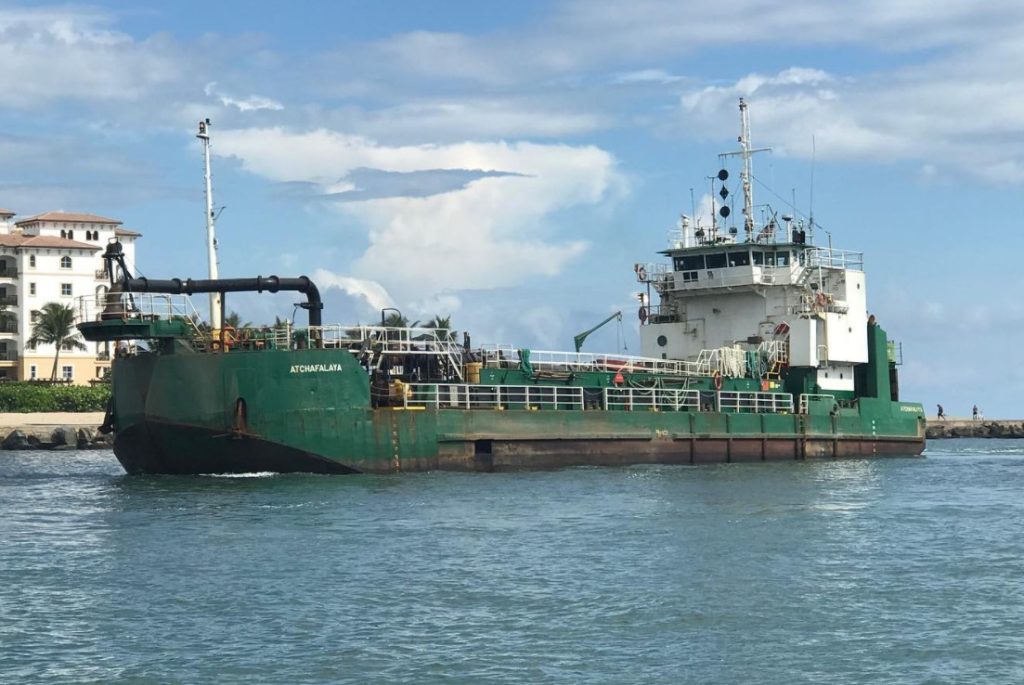
The 1950’s era, Lake Worth Inlet sand transfer plant is still alive and well today. Of course with over 60 years of continual service in an otherwise harsh environment, it should be no surprise that this pump has needed several restorations and fixes over the years to keep operational. It is certainly more cost effective to move sand with this fixed transfer pump than to call in the heavy hitting barges but one thing is for sure, as long as there are inlets, there will be sand that needs to be moved. Whether it is by a fixed pumping station or by barge, these projects must continue to not only keep inlets open and safe for navigation but to also keep a balance with Mother Nature. This pumping station is also home to the Live View, Lake Worth Inlet Cams that I view on a near daily basis. You can check it out at http://video-monitoring.com/beachcams/lakeworthinlet/

